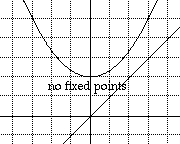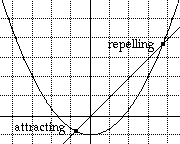1. Mathematical Experiments
1.1 Iteration
One of the great breakthroughs in mathematics in this century has been the realization that even the simplest of dynamical systems may behave extremely unpredictably. Take the real functions
| y = x2 + c | and | x = y. |
Many high school students and even some in junior high could successfully identify them as equations for a parabola and straight line respectively. There are few equations simpler than these and yet from them we can generate some rather complex and interesting behavior. Much of today's popular mathematics can be illustrated with these two equations (the kind mentioned in movies or television, often in passing and often in mutated form).
One way to interpret the functions is as two curves in the plane. A second way is as a series of instructions.
- Given some number "x", take its square and add the constant "c". Call the result "y".
- Given "y", do nothing. Call the result "x".
- Repeat step 1 with the value found in step 2.
The first two instructions together form a mapping of one number on to another:
ƒ: x → x2 + c.
If we did this for all real numbers we would be mapping the real numbers on to themselves:
ƒ: ℝ → ℝ.
The addition of the third step results in an iterated mapping. We will use the symbol ƒn(x) to represent the nth iterate of our original value "x". The instructions tell us to generate a series of numbers
x, ƒ(x), ƒ2(x), ƒ3(x), … , ƒn(x), …
which we will call the orbit. The initial value "x" is called the seed of the orbit. Note that there is no instruction telling us when to stop. Thankfully, humans are not quite so stupid as are the instructions given to them. Somewhere in this sequence, a pattern will emerge that will allow us to stop iterating and make a judgment. If it takes us too long to arrive at a decision or if we just get tired of doing all the work we can always turn it over to a computer. Let us now look at the behavior of some orbits.
The parameter c = 0 is by far the easiest to deal with as
ƒ: x → x2 + c
will yield the following results:
| ƒn → | ⎧ ⎨ ⎩ |
∞ | |x| > 1 | as | n → ∞ | |
| 1 | |x| = 1 | |||||
| 0 | |x| < 1 |
All orbits approach either zero or infinity except for those with seed x = ±1. The points zero and infinity are called attracting fixed points or sinks because they attract the orbits of the points around them while ±1 are called repelling fixed points or sources for the opposite reason.
When c > ¼ the parabola is entirely above the diagonal line and all seed values will be driven off to infinity. When c = ¼ the parabola and the diagonal line intersect at ½. Seeds with absolute value greater than ½ will expand off to infinity while those in the interval 0 ≤ |x| ≤ ½ approach ½ asymptotically. After about 700 iterations these seeds will have reached 0.499. The results of the first ten iterations for some seed values are presented in the table below.
| ±1 | ±0.75 | ±0.5 | ±0.25 | ±0.1 | 0 |
|---|---|---|---|---|---|
| +1.25 | +0.812 | +0.5 | +0.3125 | +0.26 | +0.25 |
| +1.812 | +0.910 | +0.5 | +0.3476562 | +0.3176 | +0.3125 |
| +3.535 | +1.078 | +0.5 | +0.3708648 | +0.3508697 | +0.3476562 |
| +12.747 | +1.412 | +0.5 | +0.3875407 | +0.3731096 | +0.9708648 |
| +162.744 | +2.246 | +0.5 | +0.4001878 | +0.3892107 | +0.3875407 |
| +26485.994 | +5.296 | +0.5 | +0.4101503 | +0.4014850 | +0.4001878 |
| +701507907 | +28.297 | +0.5 | +0.4182232 | +0.4111902 | +0.4101503 |
| +4.921e+17 | +800.985 | +0.5 | +0.4249107 | +0.4190774 | +0.4182232 |
| +2.421e+35 | +64158.262 | +0.5 | +0.4305491 | +0.4256258 | +0.4291070 |
| +5.864e+70 | +4.116e+11 | +0.5 | +0.4353725 | +0.4311573 | +0.4305491 |
| ⋮ | ⋮ | ⋮ | ⋮ | ⋮ | ⋮ |
| infinity | infinity | +½ | +½ | +½ | +½ |
The fixed point changes as the parameter changes, falling ever so slightly as "c" becomes smaller. The parabola and the diagonal line intersect at two points now; the roots of the equation
x2 + c = x.
Upon further analysis it can be shown that the smaller of the two roots is an attracting fixed point and the larger of the two roots is a repelling fixed point. We have already shown this for the special case of c = 0 so let's try with another easy value. When the parameter c = −¾ the equation now has roots of −½ and +1½. The results of the first ten iterations for some seed values are presented in the table below.
| ±1.75 | ±1.5 | ±1 | ±0.75 | ±0.5 | ±0.25 |
|---|---|---|---|---|---|
| +2.31 | +1.5 | +0.25 | −0.1875 | −0.5 | −0.6875 |
| +4.59 | +1.5 | −0.6875 | −0.71484375 | −0.5 | −0.2773437 |
| +20.38 | +1.5 | −0.2773437 | −0.2389984 | −0.5 | −0.6730804 |
| +414.93 | +1.5 | −0.6730804 | −0.6928797 | −0.5 | −0.2969627 |
| +172173.29 | +1.5 | −0.2969627 | −0.2699176 | −0.5 | −0.6618131 |
| +2.964e+10 | +1.5 | −0.6618131 | −0.6771444 | −0.5 | −0.3120033 |
| +8.787e+20 | +1.5 | −0.3120033 | −0.2947537 | −0.5 | −0.6525639 |
| +7.721e+41 | +1.5 | −0.6525639 | −0.6650421 | −0.5 | −0.3240428 |
| +5.962e+83 | +1.5 | −0.3240428 | −0.3077189 | −0.5 | −0.6449962 |
| overflow | +1.5 | −0.6449962 | −0.6553090 | −0.5 | −0.3339798 |
| ⋮ | ⋮ | ⋮ | ⋮ | ⋮ | ⋮ |
| infinity | +1½ | −½ | −½ | −½ | −½ |
As we suspected, +1½, the larger of the two roots is indeed a repelling fixed point, but is −½ an attractor? The answer is yes, if you wait long enough. The orbits approach −½ by oscillating between two values on either side of −½, each of which approaches this value asymptotically. This behavior can be seen in the table above and is an indication of things to come.
 |
 |
 |
For values of the parameter c < −¾, orbits that formerly would have approached the smaller of the two roots now oscillate between two distinct values. The attracting fixed point has bifurcated or split and the orbit is no longer stable but periodic, alternating between two values. As "c" becomes ever more negative another bifurcation takes place and the period doubles to 4 and then again to 8, then 16, then 32, 64, ad infinitum. The distance between successive bifurcations, however, approaches zero and does so in such a way that the period-doubling reaches infinity at a finite parameter value of about c < −1.4. Beyond this value orbits that were formerly periodic now wander over an aperiodic orbit about some finite interval within [−2, 2] and will visit every region of this interval. Such behavior is said to be ergodic and is a characteristic of chaos. In addition, seed values which are initially close to each other will, after a few iterations, follow orbits that are wildly different. This behavior, which exhibits sensitive dependence on initial conditions, is said to be chaotic and the values of the parameter "c" over which such behavior occurs is called the chaotic regime. The sequence of bifurcations leading up to the chaotic regime is known as the period-doubling route to chaos.
If this is getting too wordy, perhaps you should read on. In the sections following, these descriptions are rendered graphically.